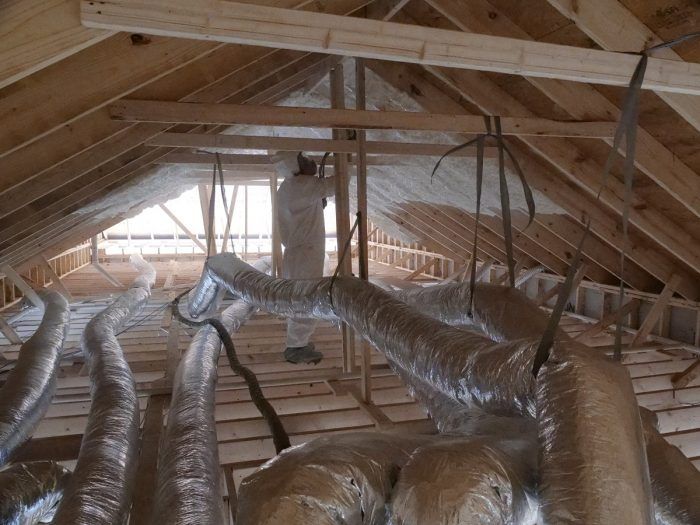Air-Sealing and Insulating
Planning ahead and focusing on the details are the keys to creating a tight envelope with Zip System sheathing and spray foam.

Air-sealing and insulation are important to us because they directly impact a homeowner’s comfort. The air barrier on the exterior of the FHB House is Zip System sheathing. The exterior coating of these panels is both a water-resistive barrier and an air barrier. To make the sheathing airtight, we need to seal the panel joints, which we did with with Zip System Liquid Flash, which is also spread over the nail heads in the field of the panel. Unlike Zip System tape, the Liquid Flash can be applied when the sheathing is wet (although the temperature has to be above freezing). The crew especially likes the liquid flash for getting a good seal on through-wall pipe penetrations, as it’s much easier and faster than tape. On the windows and roof sheathing we used Zip System tape to flash and air-seal. As an additional air-sealing measure, we used spray-foam insulation throughout the house. It’s an efficient insulator and a good backup at the transitions from foundation to wall and from wall to roof along the eaves—both areas where we sometimes find air leaks.
In the basement, the walls are framed 1½ in. off the concrete with 2 in. of closed-cell foam sprayed against the concrete. This assembly controls water-vapor diffusion to the interior and leaves plenty of room to run wires and plumbing. All of the above-grade insulation is open-cell Icynene Classic Ultra Select. Our installer recommends it because it’s a low-VOC, water-blown polyurethane spray foam. Here we sprayed to R-13. This open-cell spray foam doesn’t require an ignition barrier, so it works well in our unvented attic. The attic is part of our conditioned space, so we can run our ductwork for the forced-air heat-pump system. We sprayed R-40 to the underside of the roof sheathing.
When the insulating was done, our energy rater conducted a blower-door test to direct the insulation team to air leaks and touch them up. This is an important step with the spray foam, as the expanding foam can visually hide small areas the installer missed on the initial spray. Sealing these small air leaks brought the final blower-door result to a tight 1.42 ACH50 that will keep the house comfortable. The rater’s modeling shows our heating and cooling loads (22 kBtu per hr. and 13 kBtu per hr. respectively) will be met economically at around $250 annually with the ground-source heat pump.







Fine Homebuilding Recommended Products
Fine Homebuilding receives a commission for items purchased through links on this site, including Amazon Associates and other affiliate advertising programs.

Utility Knife

Anchor Bolt Marker

Original Speed Square









































View Comments
Open cell on the underside of the roof deck? Hasn’t that been shown to be an awful idea because of its vapor permeance? Or is that not an issue here because the climate won’t allow the psychometrics to get the water vapor passing through the foam to turn into condensation on the sheathing? Wonder about how much margin you have and whether it would be safer to pay a little more for closed cell and eliminate 99.9% of the risk...